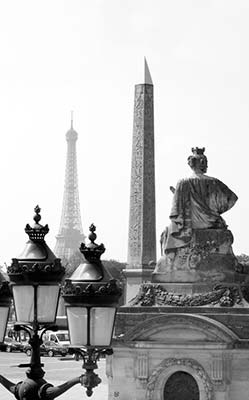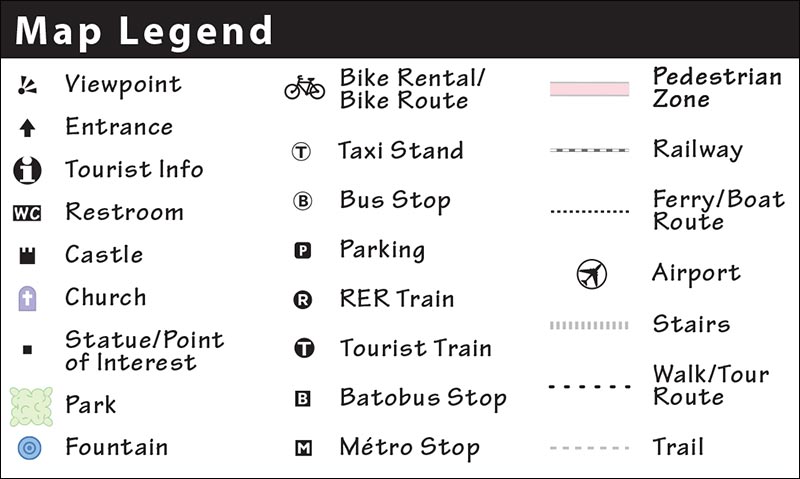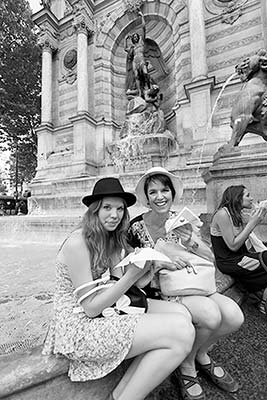
Traveling as a Temporary Local
Paris—the City of Light—has been a beacon of culture for centuries. As a world capital of art, fashion, food, literature, and ideas, it stands as a symbol of all the fine things human civilization can offer. Come prepared to celebrate this, rather than judge our cultural differences, and you’ll capture the romance and joie de vivre that this city exudes.
Paris offers sweeping boulevards, chatty crêpe stands, chic boutiques, and world-class art galleries. Sip decaf with deconstructionists at a sidewalk café, then step into an Impressionist painting in a tree-lined park. Climb Notre-Dame and rub shoulders with a gargoyle. Cruise the Seine, zip to the top of the Eiffel Tower, and saunter down Avenue des Champs-Elysées. Master the Louvre and Orsay museums. Save some after-dark energy for one of the world’s most romantic cities.
Rick Steves Paris 2017 is a personal tour guide in your pocket. Better yet, it’s actually three tour guides in your pocket: The co-authors of this book are Steve Smith and Gene Openshaw. Steve has been traveling to France—as a guide, researcher, homeowner, and devout Francophile—every year since 1985. Gene and I have been exploring the wonders of the Old World since our first “Europe through the gutter” trip together as high school buddies in the 1970s. An inquisitive historian and lover of European culture, Gene wrote most of this book’s self-guided museum tours and neighborhood walks. Together, Steve, Gene, and I keep this book current (though, for simplicity, from this point “we” will shed our respective egos and become “I”).
The book divides Paris into convenient neighborhoods (shown on “Paris Map Overview” on page XVIII). In this book, you’ll find the following chapters:

Use this legend to help you navigate the maps in this book.
Orientation to Paris has specifics on public transportation, helpful hints, local tour options, easy-to-read maps, and tourist information. The “Planning Your Time” section suggests a schedule for how to best use your limited time.
Sights in Paris describes the top attractions and includes their cost and hours.
The Self-Guided Walks cover six of Paris’ most intriguing neighborhoods: Historic Paris (including Notre-Dame and Sainte-Chapelle), Rue Cler (near the Eiffel Tower), the Left Bank, the Champs-Elysées, the Marais, and Montmartre.
The Self-Guided Tours lead you through Paris’ most fascinating museums and sights: the Louvre, Orsay, Orangerie, Eiffel Tower, Rodin Museum, Army Museum and Napoleon’s Tomb, Marmottan, Cluny, Picasso Museum, Pompidou Center, and Père Lachaise Cemetery. The Bus #69 Sightseeing Tour gives you an inexpensive overview of the city.
Sleeping in Paris describes my favorite hotels in five appealing neighborhoods (plus hotels convenient to Paris’ two main airports), from good-value deals to cushy splurges.
Eating in Paris serves up a buffet of options, from inexpensive cafés to romantic bistros, arranged by neighborhood, plus a listing of historic cafés.
Paris with Children includes my top recommendations for keeping your kids (and you) happy, along with information for visiting Disneyland Paris.
Shopping in Paris gives you tips for shopping painlessly and enjoyably, without letting it overwhelm your vacation or ruin your budget. Read up on Paris’ great department stores, neighborhood boutiques, flea markets, outdoor food markets, and arcaded, Old World shopping streets. Try the suggested boutique strolls on Place de la Madeleine, in the Left Bank, and on Rue des Martyrs.
Entertainment in Paris is your guide to fun, including live music, driving tours, and the best night walks and river cruises. You’ll also find information on how to translate Pariscope, the weekly entertainment guide.
Paris in Winter provides tips on how to enjoy the City of Light during the wonderfully untouristy holiday season and beyond.
Paris Connections lays the groundwork for your arrival and departure, covering transportation by train (including the Eurostar to London) and plane, with detailed information on Paris’ two major airports (Charles de Gaulle and Orly), a remote airport (Beauvais), and Paris’ seven train stations.
Day Trips include the great châteaux of Versailles (with a self-guided tour), Vaux-le-Vicomte, Fontainebleau, and Chantilly; Chartres’ majestic cathedral (with a self-guided tour and a town walk); and the Impressionist retreats of Claude Monet’s Giverny and Vincent van Gogh’s Auvers-sur-Oise. For those who like to linger, I list accommodations near most of these sights.
France: Past & Present gives you a quick overview of the country’s tumultuous history and contemporary challenges.
The Practicalities chapter near the end of this book is a traveler’s tool kit, with my best advice about money, sightseeing, sleeping, eating, staying connected, and transportation.
The appendix has the nuts and bolts: useful phone numbers and websites, a holiday and festival list, recommended books and films, a climate chart, a handy packing checklist, a guide to pronouncing Parisian landmarks, and French survival phrases.
Throughout this book, you’ll find money- and time-saving tips for sightseeing, transportation, and more. Some businesses—especially hotels and walking tour companies—offer special discounts to my readers, indicated in their listings.
Browse through this book and select your favorite sights. Then have a trip that’s truly formidable! Traveling like a temporary local, you’ll get the absolute most out of every mile, minute, and dollar. As you visit places I know and love, I’m happy that you’ll be meeting my favorite Parisians.
This section will help you get started planning your trip—with advice on trip costs, when to go, and what you should know before you take off.
Your trip to Paris is like a complex play—it’s easier to follow and really appreciate on a second viewing. While no one does the same trip twice to gain that advantage, reading this book in its entirety before your trip accomplishes much the same thing.
Design an itinerary that enables you to visit sights at the best possible times. Note festivals, holidays, street-market days, specifics on sights, and days when sights are closed or most crowded (all covered in this book). You can wait in line at the Louvre, or—with a Paris Museum Pass and some planning ahead—zip through without breaking a sweat. Day-tripping to Versailles on Monday is bad, since it’s closed—but it’s not recommended on Tuesday either, when the Louvre is closed and tourist mobs storm the palace. Designing a smart trip is a puzzle—a fun, doable, and worthwhile challenge.
Make your itinerary a mix of intense and relaxed stretches. Every trip—and every traveler—needs slack time (laundry, picnics, café-sitting, and so on). Pace yourself. Assume you will return.
Even with the best-planned itinerary, you’ll need to be flexible. Update your plans as you travel. Though I encourage you to disconnect from life back home and immerse yourself in the French experience, you can get online or call ahead to learn the latest on sights (special events, tour schedules, and so on), book tickets and tours, make reservations, reconfirm hotels, and research transportation connections.
Enjoy the friendliness of the French people. Connect with the culture. Learn a new French expression each day and practice it. Cheer for your favorite bowler at a boules match, leave no chair unturned in your quest for the best café, find that perfect Eiffel Tower view, and make friends with a crêpe stand. Slow down to appreciate the sincerity of your Parisian hosts, and be open to unexpected experiences. Ask questions—most locals are eager to point you in their idea of the right direction. Keep a notepad in your pocket for confirming prices, noting directions, and organizing your thoughts. Wear your money belt, learn the currency, and figure out how to estimate prices in dollars. Those who expect to travel smart, do.
Five components make up your trip costs: airfare to Europe, transportation in Europe, room and board, sightseeing and entertainment, and shopping and miscellany.
Airfare to Europe: A basic round-trip flight from the US to Paris can cost, on average, about $1,000-2,000 total, depending on where you fly from and when (cheaper in winter). If Paris is part of a longer European trip, consider saving time and money by flying into one city and out of another; for instance, into Paris and out of Rome. Overall, Kayak.com is the best place to start searching for flights on a combination of mainstream and budget carriers.
Transportation in Europe: For a typical one-week visit, allow about $65 for Métro tickets and a couple of day trips by train. To get between Paris and either major airport, figure $30-125 round-trip, depending on which option you choose.
Room and Board: You can manage comfortably in Paris in 2017 on $195 a day per person for room and board. This allows $15 for breakfast, $20 for lunch with a drink, $50 for dinner with drinks, and $110 for lodging (based on two people splitting the cost of a $220 double room). If you’ve got more money, I’ve listed great ways to spend it. Students and tightwads can enjoy Paris for as little as $70 a day ($35 for a bed, $35 for meals and snacks).
Sightseeing and Entertainment: Get the Paris Museum Pass, which covers most sights in the city (for more information, see here). You’ll pay about $55 for a two-day pass. Without a Museum Pass, figure about $15 per major sight, $10 for others. Add $20-60 for bus tours and splurge experiences (such as walking tours and concerts in Sainte-Chapelle). An overall average of $40 a day works for most people. Don’t skimp here. After all, this category is the driving force behind your trip—you came to sightsee, enjoy, and experience Paris.
Shopping and Miscellany: Figure $4 per ice cream cone, coffee, or soft drink. Shopping can vary in cost from nearly nothing to a small fortune. Good budget travelers find that this category has little to do with assembling a trip full of lifelong memories.
Late spring and fall bring the best weather and the biggest crowds. May, June, September, and October are the toughest months for hotel-hunting—don’t expect many hotel deals. Summers are generally hot and dry; if you wilt in the heat, look for a room with air-conditioning. Rooms are easy to land in August (some hotels offer deals), and though many French businesses close in August, you’ll hardly notice.
Paris makes a great winter getaway (see the Paris in Winter chapter). Airfare costs less, cafés are cozy, and the city feels lively but not touristy. The only problem—weather—is solved by dressing warmly, with layers. Expect cold (even freezing lows) and rain (hats, gloves, scarves, umbrellas, and thick-soled shoes are essential). For specific temperatures, see the climate chart in the appendix.
Check this list of things to arrange while you’re still at home.
You need a passport—but no visa or shots—to travel in France. You may be denied entry into certain European countries if your passport is due to expire within six months of your ticketed date of return. Get it renewed if you’ll be cutting it close. It can take up to six weeks to get or renew a passport (for more on passports and requirements for France, see www.travel.state.gov). Pack a photocopy of your passport in your luggage in case the original is lost or stolen.
Book rooms well in advance if you’ll be traveling during peak season (April through October) or any major holidays (see here). Some famous restaurants (but not ones I recommend) require reservations several weeks in advance.
Call your debit- and credit-card companies to let them know the countries you’ll be visiting, ask about fees, to request your PIN if you don’t already know it, and more. See here for details.
Do your homework if you’re considering travel insurance. Compare the cost of the insurance to the cost of your potential loss. Also check whether your existing insurance (health, homeowners, or renters) covers you and your possessions overseas. For more tips, see www.ricksteves.com/insurance.
High-speed trains (TGVs) in France require a seat reservation; book as early as possible, as these trains fill fast, and some routes use TGV trains almost exclusively. This is especially true if you’re traveling with a rail pass, as TGV pass-holder reservations are limited, and usually sell out well before other seat reservations do (look also for online deals for individual ticket purchases at http://en.voyages-sncf.com). For more on train travel, see here.
To avoid long ticket-buying lines at the Eiffel Tower, book an entry time several months in advance using its online reservation system (see here).
If seeing the City of Light at night from a taxi or Uber appeals to you, photocopy the “Floodlit Paris Driving Tour” (in the Entertainment in Paris chapter) to bring along and give to your driver.
If you plan to hire a local guide, reserve ahead by email. Popular guides can get booked up. For suggestions see here.
If you’re bringing a mobile device, consider signing up for an international plan for cheaper calls, texts, and data (see here). Download any apps you might want to use on the road, such as translators, maps, transit schedules, and Rick Steves Audio Europe (see here).
If you’ll be traveling with children, read over the list of pretrip suggestions on here.
Check for recent updates to this book at www.ricksteves.com/update.
We travel all the way to France to enjoy differences—to become temporary locals. You’ll experience frustrations. Certain truths that we find “God-given” or “self-evident,” such as cold beer, ice in drinks, bottomless cups of coffee, “the customer is king,” and bigger being better, are suddenly not so true. One of the benefits of travel is the eye-opening realization that there are logical, civil, and even better alternatives.

Paris is an understandably proud city. To enjoy its people, you need to celebrate the differences. A willingness to go local ensures that you’ll enjoy a full dose of Parisian hospitality. And with an eagerness to go local, you’ll have even more fun.
Europeans generally like Americans. But if there is a negative aspect to the French image of Americans, it’s that we are loud, wasteful, ethnocentric, too informal (which can seem disrespectful), and a bit naive.
The French (and Europeans in general) place a high value on speaking quietly in public places. Listen while on the bus or in a restaurant—the place can be packed, but the decibel level is low. Try to adjust your volume accordingly to show respect for the culture.
While the French look bemusedly at some of our Yankee excesses—and worriedly at others—they nearly always afford us individual travelers all the warmth we deserve.
Judging from all the happy feedback I receive from travelers who have used this book, it’s safe to assume you’ll enjoy a great, affordable vacation—with the finesse of an independent, experienced traveler.
Thanks, and bon voyage!
